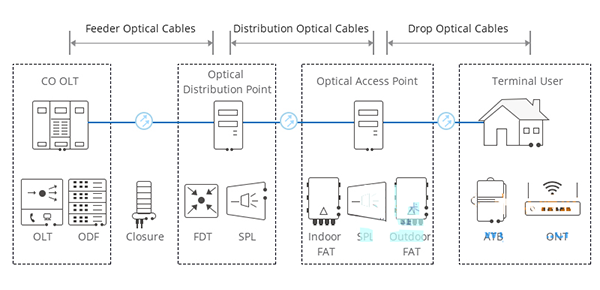

 Knowledge Base +
Knowledge Base +  2024.01.05
2024.01.05Fiber to the Home (FTTH) has begun to receive attention from telecom companies around the world, and the technology has evolved rapidly. Active Optical Networks (AONs) and Passive Optical Networks (PONs) are the two main systems that make up FTTH broadband connectivity, and PONs, which can provide cost-effective solutions, are more prevalent in most FTTH deployments.
In this article, we will introduce the basics of PON, which mainly involves OLT, ONT, ONU, ODN and other basic components and related technologies.
PON Explained: Definition, Standards and Advantages
Passive Optical Networks (PONs) are fiber optic networks that utilize a point-to-multipoint topology and splitters to transport data from a single transmission point to multiple customer endpoints. In contrast to AONs, multiple customers are connected to a single transceiver via a fiber optic branching tree and a passive splitter/combiner unit that operates exclusively in the optical domain, with no power supply in the PON architecture.
There are two main PON standards: Gigabit Passive Optical Network (GPON) and Ethernet Passive Optical Network (EPON).
Their topologies are essentially the same, and as the preferred choice for many FTTH deployment scenarios, PON solutions have several outstanding benefits:
Lower power consumption
Less space required
Higher bandwidth
Higher levels of security
Easier installation and expansion
Lower O&M costs
PON Architecture and Components
In a Gigabit Ethernet Passive Optical Network (GEPON) system, there is an Optical Line Terminal (OLT) at the central office of the service provider, and multiple Optical Network Units (ONUs) or Optical Network Terminals (ONTs) near the end-users that act as Split Points (SPLs). In addition, ODN (Optical Distribution Network) is used for transmission between OLT and ONU/ONT.
Optical Line Terminal (OLT)
The OLT is the starting point of the passive optical network, which is connected to the core switch via an Ethernet cable.
The primary function of the OLT is to convert, frame, and transmit signals for the PON network and to coordinate the multiplexing of optical network terminals to share uplink transmissions.
The OLT equipment generally contains a rack, CSM (Control and Switch Module), ELM (EPON Link Module, PON card), redundant protection-48V DC power module or one 110/220V AC power module, and fan.
Among these parts, the PON card and power supply support hot-swapping while another module is built-in. the OLT has two floating directions: upstream (distributing different types of data and voice traffic from subscribers) and downstream (acquiring data, voice,
Optical Network Unit (ONU)/Optical Network Terminal (ONT)
The ONU converts optical signals transmitted over optical fibers into electrical signals. These electrical signals are then sent to individual subscribers.
Typically, there is a distance or other access network between the ONU and the end user's residence. In addition, the ONU can send, aggregate, and collate different types of data from the customer and send it up to the OLT.
Collation is the process of optimizing and restructuring the flow of data for more efficient delivery, The OLT supports bandwidth allocation, allowing smooth floating of data to the OLT, which typically arrives from the customer in bursts, The ONU can be connected in a variety of ways and cable types, such as twisted-pair copper, coaxial cables, fiber optics, or via Wi-Fi.
The end-user device can also be referred to as an optical network terminal (ONT). In fact, an ONT is essentially the same as an ONU. An ONT is an ITU-T term, while an ONU is an IEEE term, and belongs to a different body of standards. Both refer to the user-side equipment in a GEPON system, but in practice there is a slight difference between an ONT and an ONU depending on where they are located.
Optical Distribution Network (ODN)
The ODN is the component of a PON system that provides the optical transport medium for the physical connection from the ONU to the OLT over distances of 20 kilometers or more.
Within the ODN, fiber optic cables, fiber optic connectors, passive optical splitters, and ancillary components work together.
The ODN is specifically divided into five segments: feeder fiber, optical distribution point, distribution fiber, optical access point and introduction fiber.
Feeder fiber starts from the optical distribution frame (ODF) in the central office telecom room and terminates at the optical distribution point for long-distance coverage.
Distribution fiber from the optical distribution point to the optical access point for the area next to it to distribute fiber, the introduction of fiber to connect the optical access point to the terminal (ONT), to achieve fiber to the home, in addition, the ODN is an indispensable path for PON data transmission, and its quality has a direct impact on the performance, reliability and scalability of the PON system.

Conclusion
OLTs, ONUs or ONTs, and ODNs are the main components of a GEPON system, which are now widely used in FTTH applications.Reduced cabling infrastructure (no active components) and flexible media delivery help to make passive optical networks more suitable for in-home Internet, voice, and video applications. In addition, passive optical networks can be used in university campuses and commercial environments to provide cost-effective solutions, and their potential applications continue to expand as PON technology continues to advance.
Subscribe to the newsletter
for all the latest updates.
2-5# Building, Tongfuyu Industrial Zone, Aiqun Road, Shiyan Street, Baoan District, Shenzhen. China
